clutch TOYOTA tC 2015 Owners Manual (in English)
[x] Cancel search | Manufacturer: TOYOTA, Model Year: 2015, Model line: tC, Model: TOYOTA tC 2015Pages: 492, PDF Size: 9.55 MB
Page 150 of 492
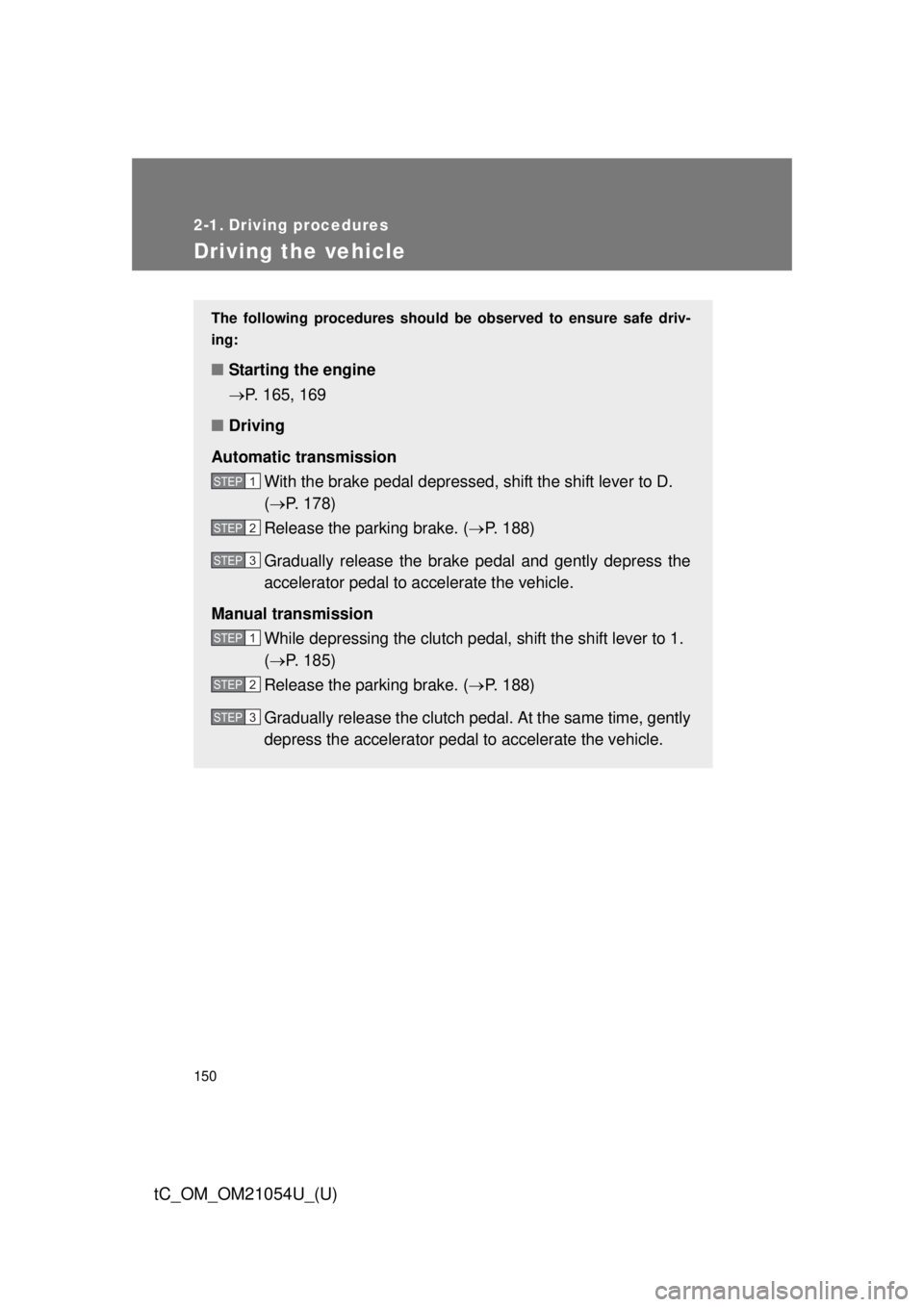
150
tC_OM_OM21054U_(U)
2-1. Driving procedures
Driving the vehicle
The following procedures should be observed to ensure safe driv-
ing:
■ Starting the engine
P. 165, 169
■ Driving
Automatic transmission With the brake pedal depressed, shift the shift lever to D.
( P. 178)
Release the parking brake. ( P. 188)
Gradually release the brake pedal and gently depress the
accelerator pedal to accelerate the vehicle.
Manual transmission While depressing the clutch pedal, shift the shift lever to 1.
( P. 185)
Release the parking brake. ( P. 188)
Gradually release the clutch pedal. At the same time, gently
depress the accelerator pedal to accelerate the vehicle.
STEP 1
STEP 2
STEP 3
STEP 1
STEP 2
STEP 3
Page 151 of 492
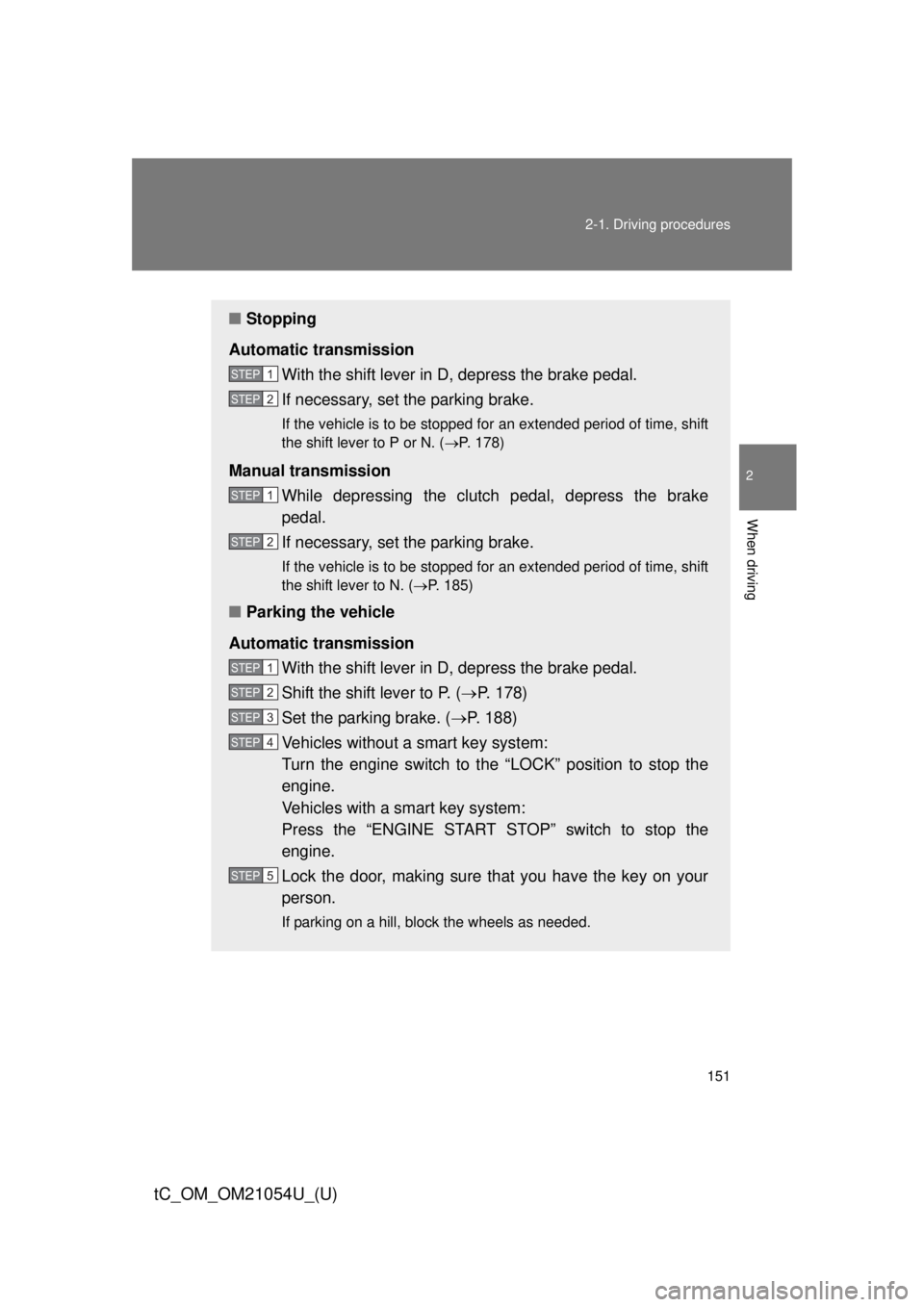
151
2-1. Driving procedures
2
When driving
tC_OM_OM21054U_(U)
■
Stopping
Automatic transmission With the shift lever in D, depress the brake pedal.
If necessary, set the parking brake.
If the vehicle is to be stopped for an extended period of time, shift
the shift lever to P or N. ( P. 178)
Manual transmission
While depressing the clutch pedal, depress the brake
pedal.
If necessary, set the parking brake.
If the vehicle is to be stopped for an extended period of time, shift
the shift lever to N. ( P. 185)
■Parking the vehicle
Automatic transmission With the shift lever in D, depress the brake pedal.
Shift the shift lever to P. ( P. 178)
Set the parking brake. ( P. 188)
Vehicles without a smart key system:
Turn the engine switch to the “LOCK” position to stop the
engine.
Vehicles with a smart key system:
Press the “ENGINE START STOP” switch to stop the
engine.
Lock the door, making sure that you have the key on your
person.
If parking on a hill, block the wheels as needed.
STEP 1
STEP 2
STEP 1
STEP 2
STEP 1
STEP 2
STEP 3
STEP 4
STEP 5
Page 152 of 492
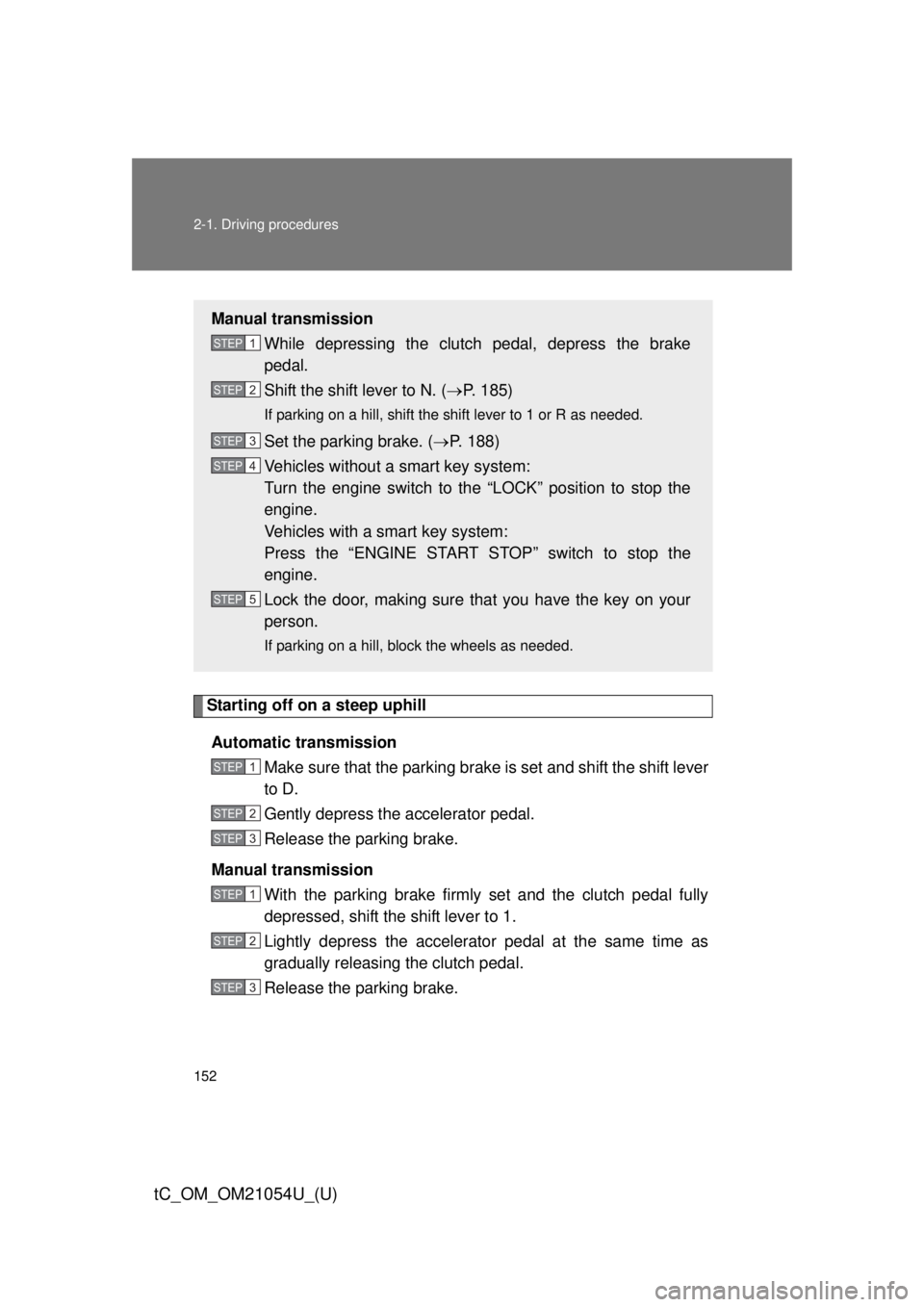
152 2-1. Driving procedures
tC_OM_OM21054U_(U)
Starting off on a steep uphillAutomatic transmission Make sure that the parking brake is set and shift the shift lever
to D.
Gently depress the accelerator pedal.
Release the parking brake.
Manual transmission With the parking brake firmly set and the clutch pedal fully
depressed, shift the shift lever to 1.
Lightly depress the accelerator pedal at the same time as
gradually releasing the clutch pedal.
Release the parking brake.
Manual transmissionWhile depressing the clutch pedal, depress the brake
pedal.
Shift the shift lever to N. ( P. 185)
If parking on a hill, shift the shift lever to 1 or R as needed.
Set the parking brake. ( P. 188)
Vehicles without a smart key system:
Turn the engine switch to the “LOCK” position to stop the
engine.
Vehicles with a smart key system:
Press the “ENGINE START STOP” switch to stop the
engine.
Lock the door, making sure that you have the key on your
person.
If parking on a hill, block the wheels as needed.
STEP 1
STEP 2
STEP 3
STEP 4
STEP 5
STEP 1
STEP 2
STEP 3
STEP 1
STEP 2
STEP 3
Page 162 of 492

162 2-1. Driving procedures
tC_OM_OM21054U_(U)
NOTICE
■When driving the vehicle (vehicles with an automatic transmission)
● Do not depress the accelerator and brake pedals at the same time during
driving, as this may restrain driving torque.
● Do not use the accelerator pedal or depress the accelerator and brake
pedals at the same time to hold the vehicle on a hill.
■ When driving the vehicle (vehic les with a manual transmission)
● Do not depress the accelerator and brake pedals at the same time during
driving, as this may restrain driving torque.
● Do not shift gears unless the clutch pedal is fully depressed. After shifting,
do not release the clutch pedal abruptly. Doing so may damage the clutch,
transmission and gears.
● Observe the following to prevent the clutch from being damaged.
• Do not rest your foot on the clutch pedal while driving.
Doing so may cause clutch trouble.
• Do not use any gear other than the 1st gear when starting off and mov- ing forward.
Doing so may damage the clutch.
• Do not use the clutch to hold the vehicle when stopping on an uphill grade.
Doing so may damage the clutch.
● Do not shift the shift lever to R when the vehicle is still moving. Doing so
may damage the clutch, transmission and gears.
Page 165 of 492
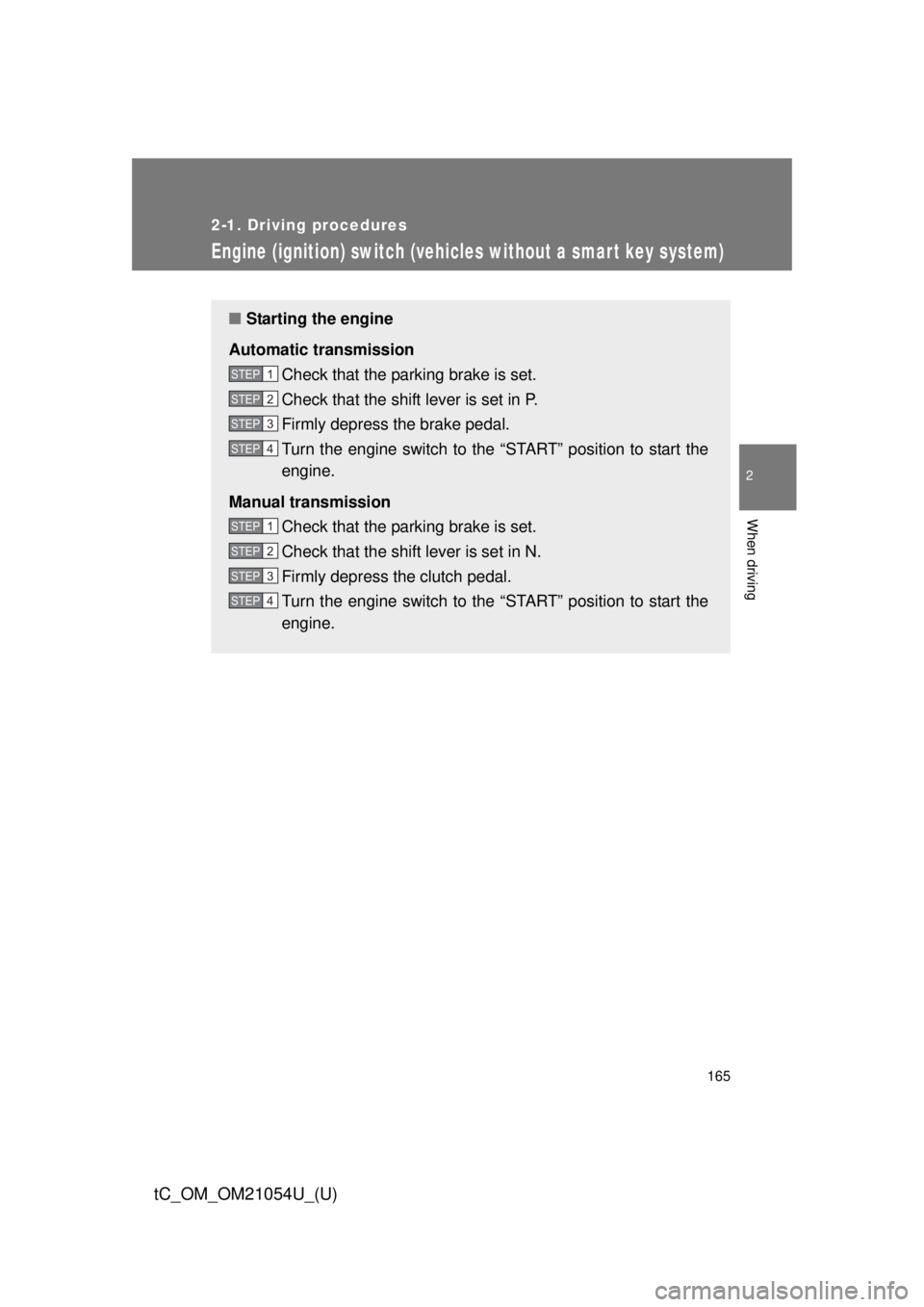
165
2-1. Driving procedures
2
When driving
tC_OM_OM21054U_(U)
Engine (ignition) switch (vehicles without a smar t key system)
■Starting the engine
Automatic transmission Check that the parking brake is set.
Check that the shift lever is set in P.
Firmly depress the brake pedal.
Turn the engine switch to the “START” position to start the
engine.
Manual transmission Check that the parking brake is set.
Check that the shift lever is set in N.
Firmly depress the clutch pedal.
Turn the engine switch to the “START” position to start the
engine.
STEP 1
STEP 2
STEP 3
STEP 4
STEP 1
STEP 2
STEP 3
STEP 4
Page 170 of 492
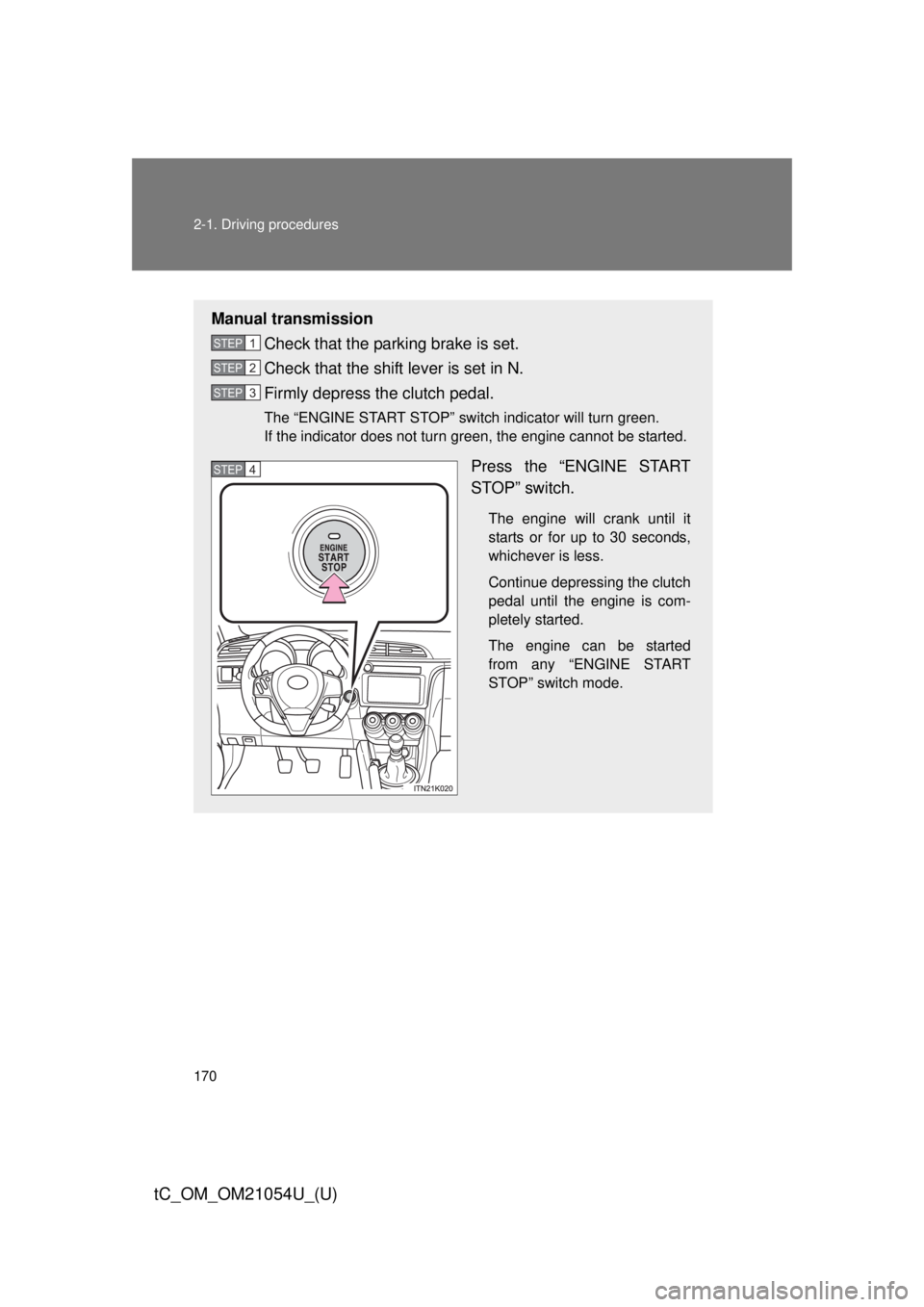
170 2-1. Driving procedures
tC_OM_OM21054U_(U)
Manual transmissionCheck that the parking brake is set.
Check that the shift lever is set in N.
Firmly depress the clutch pedal.
The “ENGINE START STOP” switch indicator will turn green.
If the indicator does not turn green, the engine cannot be started.
Press the “ENGINE START
STOP” switch.
The engine will crank until it
starts or for up to 30 seconds,
whichever is less.
Continue depressing the clutch
pedal until the engine is com-
pletely started.
The engine can be started
from any “ENGINE START
STOP” switch mode.
STEP 1
STEP 2
STEP 3
STEP 4
Page 172 of 492
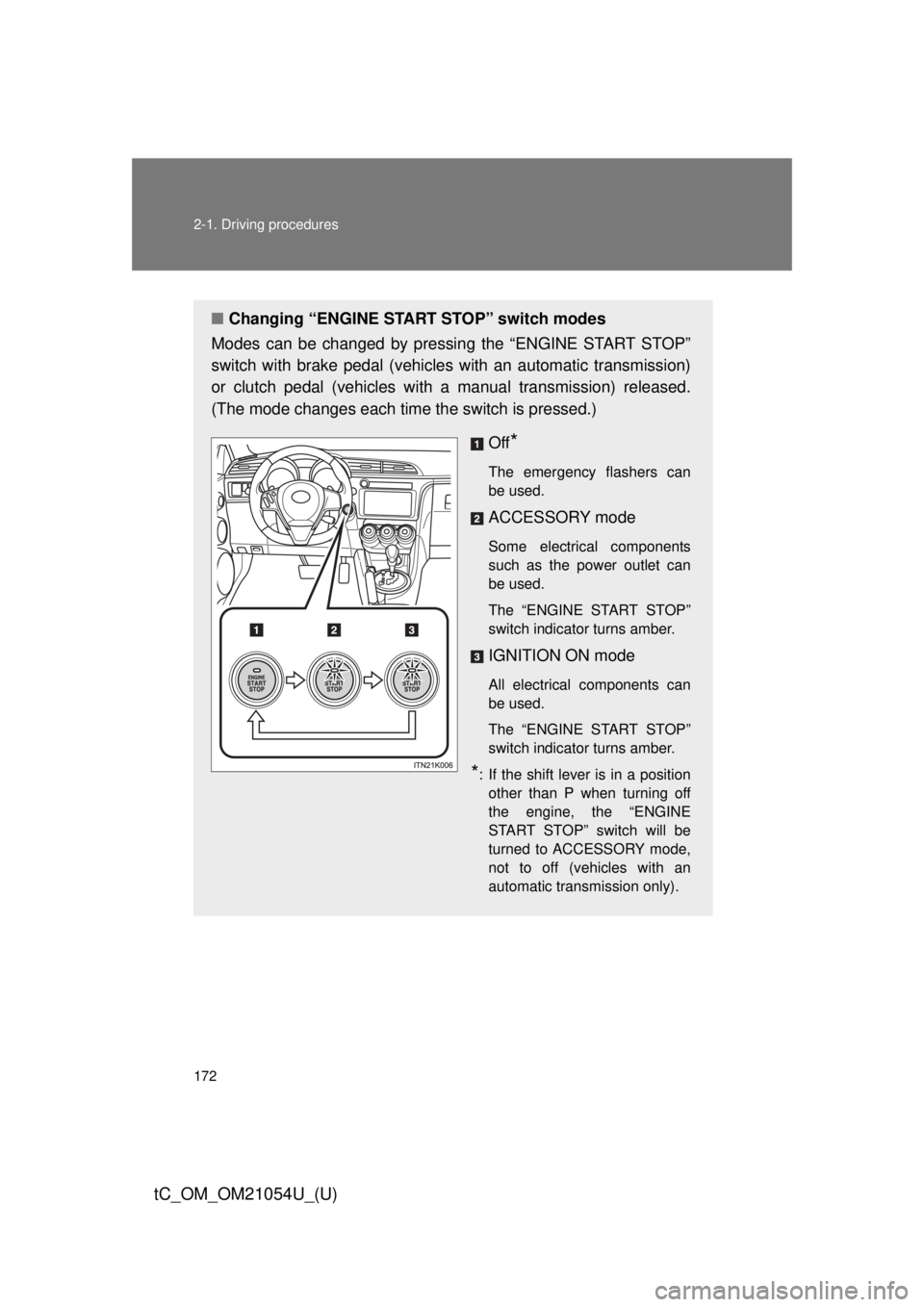
172 2-1. Driving procedures
tC_OM_OM21054U_(U)
■Changing “ENGINE START STOP” switch modes
Modes can be changed by pressing the “ENGINE START STOP”
switch with brake pedal (vehicles with an automatic transmission)
or clutch pedal (vehicles with a manual transmission) released.
(The mode changes each time the switch is pressed.)
Off
*
The emergency flashers can
be used.
ACCESSORY mode
Some electrical components
such as the power outlet can
be used.
The “ENGINE START STOP”
switch indicator turns amber.
IGNITION ON mode
All electrical components can
be used.
The “ENGINE START STOP”
switch indicator turns amber.
*: If the shift lever is in a positionother than P when turning off
the engine, the “ENGINE
START STOP” switch will be
turned to ACCESSORY mode,
not to off (vehicles with an
automatic transmission only).
Page 185 of 492
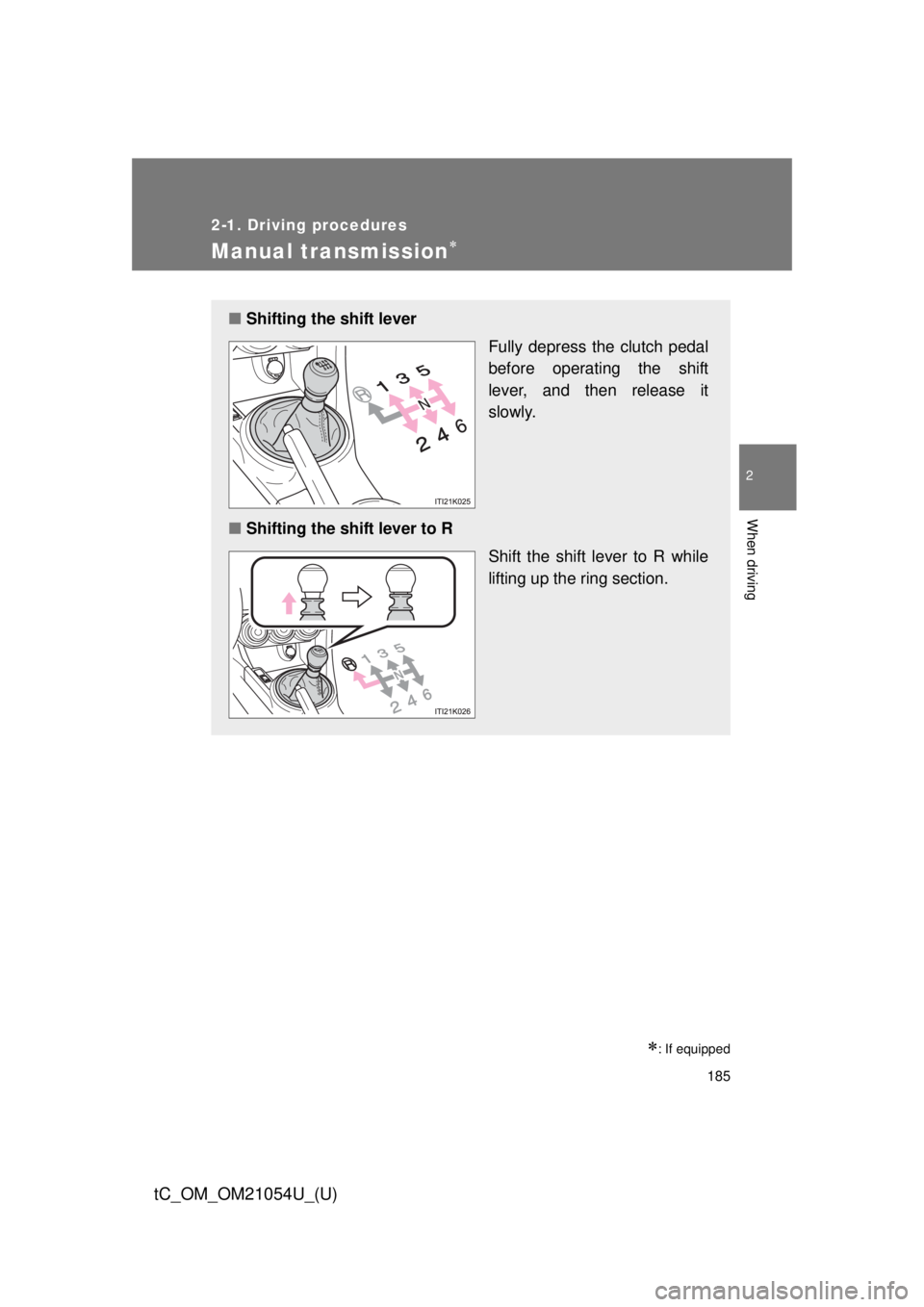
185
2-1. Driving procedures
2
When driving
tC_OM_OM21054U_(U)
Manual transmission
: If equipped
■Shifting the shift lever
Fully depress the clutch pedal
before operating the shift
lever, and then release it
slowly.
■ Shifting the shift lever to R
Shift the shift lever to R while
lifting up the ring section.
Page 186 of 492
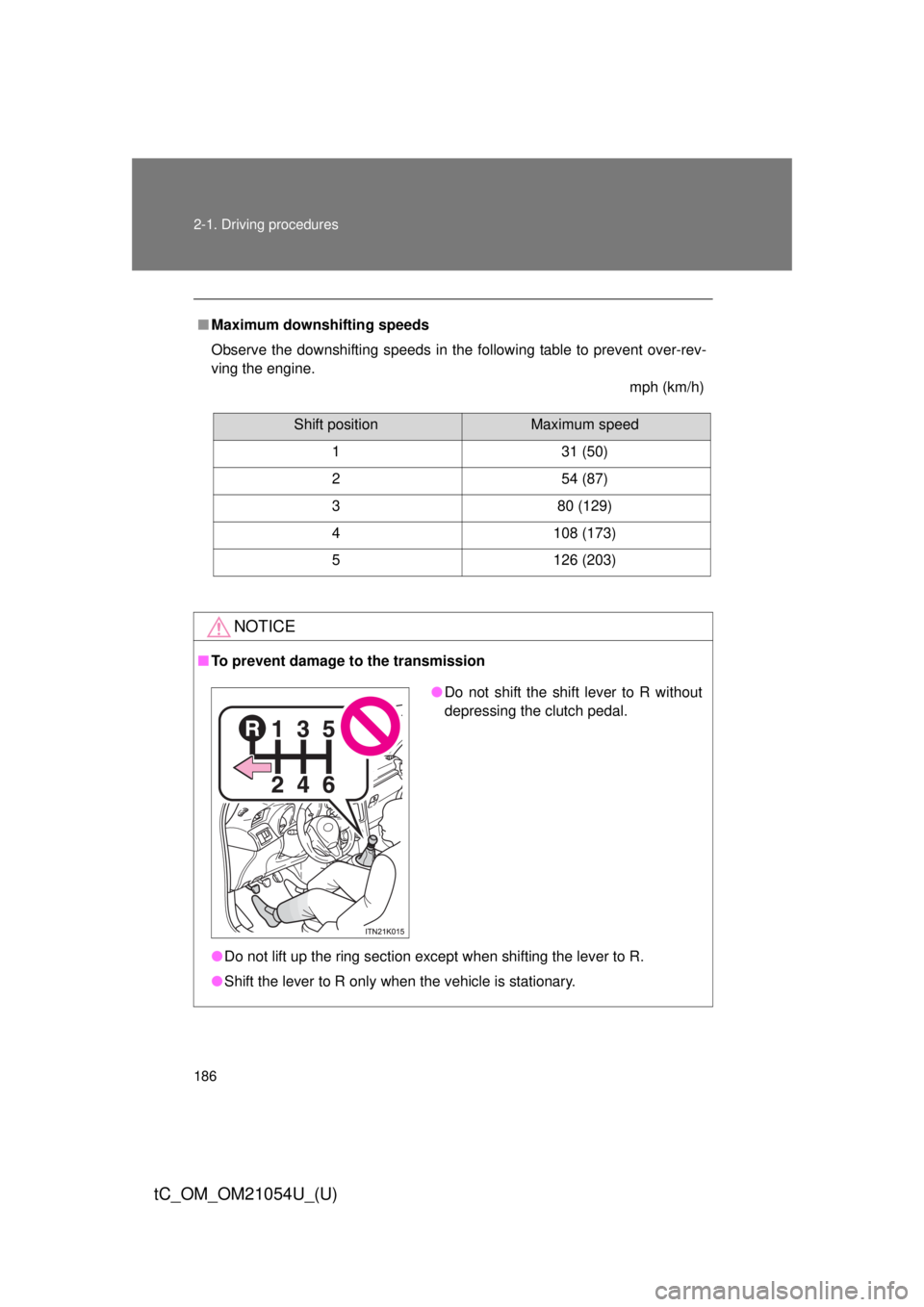
186 2-1. Driving procedures
tC_OM_OM21054U_(U)
■Maximum downshifting speeds
Observe the downshifting speeds in the following table to prevent over-rev-
ving the engine.
mph (km/h)
NOTICE
■To prevent damage to the transmission
●Do not lift up the ring section except when shifting the lever to R.
● Shift the lever to R only when the vehicle is stationary.
Shift positionMaximum speed
1 31 (50)
2 54 (87)
3 80 (129)
4 108 (173)
5 126 (203)
● Do not shift the shift lever to R without
depressing the clutch pedal.
Page 212 of 492
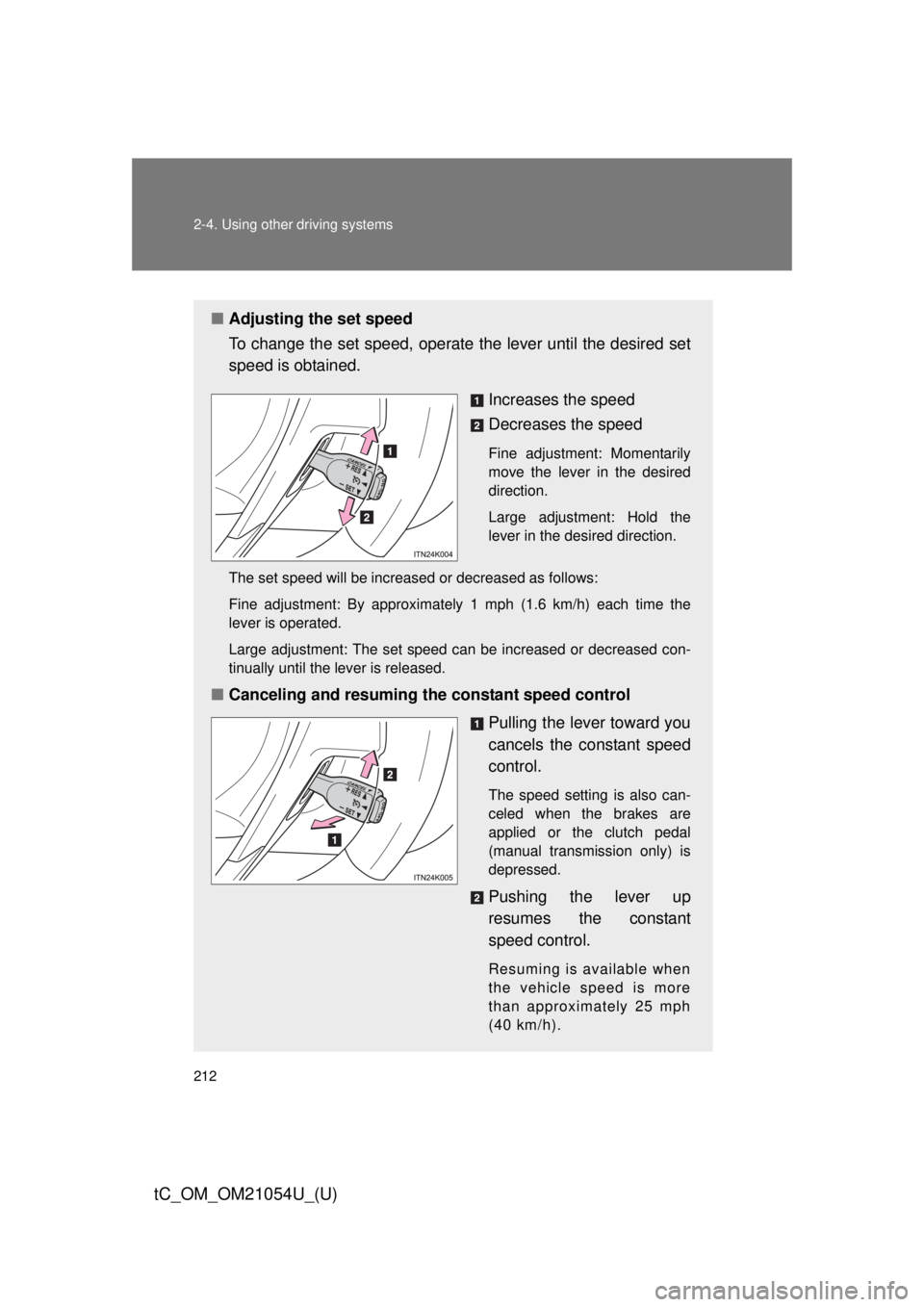
212 2-4. Using other driving systems
tC_OM_OM21054U_(U)
■Adjusting the set speed
To change the set speed, operate the lever until the desired set
speed is obtained.
Increases the speed
Decreases the speed
Fine adjustment: Momentarily
move the lever in the desired
direction.
Large adjustment: Hold the
lever in the desired direction.
The set speed will be increased or decreased as follows:
Fine adjustment: By approximately 1 mph (1.6 km/h) each time the
lever is operated.
Large adjustment: The set speed can be increased or decreased con-
tinually until the lever is released.
■ Canceling and resuming the constant speed control
Pulling the lever toward you
cancels the constant speed
control.
The speed setting is also can-
celed when the brakes are
applied or the clutch pedal
(manual transmission only) is
depressed.
Pushing the lever up
resumes the constant
speed control.
Resuming is available when
the vehicle speed is more
than approximately 25 mph
(40 km/h).